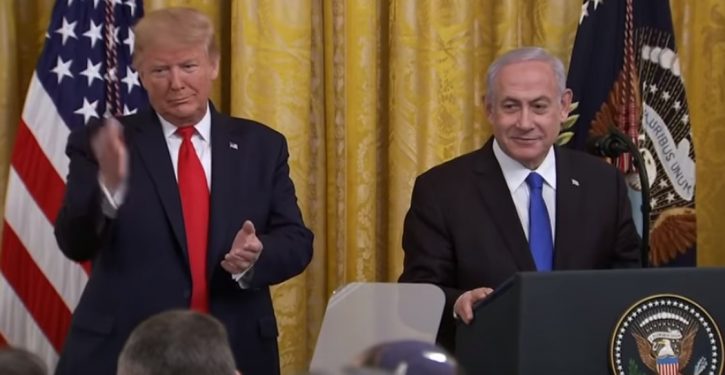
On Tuesday, President Trump rolled out his long-awaited “Deal of the Century” proposal for creating a Palestinian state and moving toward a final status agreement between Israel and the Palestinian Arabs. (Video of remarks at the bottom.)
The proposal, three years in the making, is uniquely sensible and pragmatic, focused on a set of goals that would render a Palestinian political entity eligible and fully resourced for responsible statehood. Unlike previous proposals, this one doesn’t put the cart before the horse. It doesn’t commit to a map and then try to make up for the unrealism of the territorial plan with an elaborate, unworkable arrangement for security management (e.g., bringing in third parties to perform duties that Palestinian political leaders don’t want Israel to undertake).
Instead, it leaves the decisive weight of territorial security management with Israel. The Palestinian state is to be demilitarized; indeed, its conceptual boundaries are drawn with no eye to future militarization. In terms of conventional warfare, the Trump proposal clearly regards it as having no militarizable future. The territorial concept for the Palestinian state is about accommodating population and facilitating economic success.
Will this presidential election be the most important in American history?
Thus, the conceptual map envisions no hybrid forms of security areas. Israel is responsible for all military security, which in effect is the current status quo, and there is no concept of seeing that change.
Therefore, it will work perfectly well for the Palestinian state if Israel retains the 15 “settlement” areas remaining in the Palestinian area of the conceptual map, just as it will work for Israel if the Palestinian state is situated – indeed, somewhat scattered – on territory Israel must have military oversight of to be nationally defensible.
There is, of course, an immediate question whether the Palestinian political leadership will engage with the Trump proposal. The initial response has been negative. That was to be expected, since the Palestinian leadership has always been recalcitrant about actually engaging with a peace plan. But it is presumably due in some part to the conceptual map.
The map lacks a contiguous territorial connection between the West Bank and Gaza, and it offers no separately administered portals for access across the frontier with Jordan or Egypt. Although it awards more territory in the West Bank than the Palestinian Authority has actual use of today, there are “holes” in the territory, where Israel would retain sovereign authority and use. The only stretch of Palestinian territory that lies directly adjacent to an international border is on Gaza’s southwest end – i.e., no change from the existing situation.

These aspects of the proposal tend to seem like drawbacks, viewed through the longstanding mindset that a “peace plan” is about carving out a fully formed Palestinian state regardless of how unrealistic that is for Israeli security or the stability of the region.
David Harsanyi made the excellent point at National Review that the Trump proposal does a signal service, even though, in Harsanyi’s view, it probably won’t go anywhere. The service it does is to drop the “poisonous fictions that have held back negotiations for decades,” and to “favor reality, laying out the only plausible path to a new Palestinian state.”
In that spirit, the measuring stick for the territorial concept is not what it lacks in terms of the unrealistic expectations for past proposals. The measuring stick is how it structures thinking about a different approach, one that starts by first making a Palestinian state feasible.
The Palestinian state perspective
For the benefit of the Palestinian state, the map is drawn to offer modern, efficient transportation corridors between non-contiguous and gapped territories. It envisions a network of bridges and/or tunnels in the mountains north and south of Jerusalem, as well as a rail tunnel to Gaza.
It also depicts Palestinian port facilitates to be located at Haifa and Ashdod, with the ports themselves remaining fully under Israeli security control and administration. Transportation between Palestinian territory and the ports would be via the Israeli infrastructure.
On the southern edge of Judea, the Palestinian state would be granted access to a tourism and resort concession on the Dead Sea.
There is a swath of territorial extension south of Gaza as well, with two areas linked by a roadway for agriculture and industry.
The Palestinian state would have transportation access to two border crossings with Jordan, using the Israeli infrastructure and in the context of Israel exercising sovereignty over the Jordan Valley territory. The Trump proposal suggests Jordan and the Palestinian state may negotiate a port concession for the Palestinians at Aqaba, operated on a model similar to the ones at Ashdod and Haifa. The Jordanian transportation network would move goods to the border crossing points with Israel in the Jordan River Valley.
The Palestinian state would use the international airports in Israel (Ben Gurion) and Amman, Jordan, as the PA-administered territories do today.
In Gaza, the peace plan lays out a concept for pacifying and demilitarizing the territory, such that it can be trusted when the goals are met to host an airport and a seaport (which the plan envisions as an artificial island facility). The plan’s goals must be met to advance this vision, and the earliest window for certification would be the five-year mark from adopting the plan.
The Israeli perspective
It is as easy to object to the map from the viewpoint of Israeli concerns as it is from that of the Palestinian Arabs. But, again, the Trump proposal isn’t about trying to suddenly start administering a pair of quasi-equally empowered states with national military responsibilities. It’s only about administering one such state: Israel.
If that concept isn’t bought into at the outset, the plan can’t be taken any further. But for analysis’s sake, let us suppose it is bought into.
The Trump concept has the advantage that it doesn’t require Israel to relinquish security responsibility at any border to a third-party consortium. Rather, the plan’s goal is for Israel’s final-status border to be defensible by Israel, and to be recognized by the other nations of the region. Trump’s plan makes no apology for this, and in fact, as Eugene Kontorovich noted on Tuesday, the proposal has a signal feature: recognition that Israel is not “occupying” the West Bank, and would not be “annexing” it, but in fact has a valid entitlement to it.
To be clear, US not recognising Israeli annexation of Palestinian land. It is recognising that Israel has always had a legitimate claim on this land. And that is huge.
— Eugene Kontorovich (@EVKontorovich) January 28, 2020
The point traces ultimately to the most recent internationally recognized instrument – the San Remo agreement of 1922 – which assigned the West Bank of the Jordan to a Jewish state in the British Mandate of Palestine.
In other words, Israel is already entitled to the territory she currently has de facto control of in Judea and Samaria, and can legitimately retain it under any two-state plan.
In effect – recalling Harsanyi’s point about dropping delusions in favor of reality – this is the key, right here. Acknowledging that a defensible-border delineation for Israel is not a casus belli, and violates no expectations from recognized precedent or law, is the indispensable premise for a two-state outcome. Only that premise allows both Israel and a Palestinian state to make territorial accommodations that would, in the absence of that premise, be odd and unreasonable.
Trump’s proposal is about making the determination to destroy Israel through a state of Palestine go away. And the proposal is structured to require it to go away, as a condition of greater autonomy and increased economic power for the Palestinian state.
Again, it is easy and reflexive to assume that the current Palestinian leadership won’t go along with that concept. That bet seems pretty safe.
If it did, however, the balance of vulnerability for Israel looks interestingly crafted. There are two vectors of vulnerability: first, vis-à-vis outside threats, and second, vis-à-vis the Palestinian state itself.
With regard to outside threats, the proposal’s cession of military security responsibility to Israel is comprehensive. This makes it the best proposal I can recall for a two-state solution. The existing conditions are optimal too, with sovereignty recently extended over the Golan Heights territory. Israel would have no points of exterior vulnerability to which she would not have sovereign access for defense purposes.
The Trump proposal also provides for “at least one” early warning post for Israel in the Palestinian state territory in the West Bank – a necessity given the superior terrain height in the mountains.
What the proposal dispenses with, meanwhile, is the longstanding concern, based on unadjusted political realities, that Israel would have to be equally focused on a threat from the territory of the Palestinian state.
The major drawback of previous proposals, like that of Obama and Kerry, has been accepting that vulnerability, as a consequence of allocating territory for a Palestinian state with some level of autonomous military defensibility, and trying to make a package of ad hoc security arrangements address it.

The Trump proposal obviates that perennial hazard. Since the Palestinian state is not to have a military dimension, it can meander through the mountains, interrupt Israeli territory and be interrupted by it, and be located in some places at a higher elevation than Israeli territory, and in other places lower.
In the Trump plan, the Palestinian state would be like, say, Liechtenstein or Andorra, in terms of the security meaning of its frontier.
There are obvious questions for Israelis, such as how realistic it is to believe a Palestinian state formed on this premise will not be turned against them. (The border barrier, notably, is to remain between the two states.)
A particular concern is the proposed network of tunnels for Palestinian transport, some in the mountains and one longer one running from Judea to Gaza.
My own view is that the longer Judea-Gaza tunnel, especially, would be a non-starter. In the shorter mountain tunnels, Israel would have to be vigilant about preventing undesirable things from being brought to them (they would be obvious places for clandestine storage). With the Judea-Gaza tunnel, the tunnel itself would be the corridor not only for moving undesirable things between non-contiguous territories, but potentially for spawning a whole group of launch points for attacks against Israel.
All the obvious things about keeping rockets and mortars out of the hands of Palestinian terrorists would still be there to be said. But Israel’s control of the perimeter necessary to suppress that threat would remain what it is now. That latter condition is what makes the distribution of territory in the “Deal of the Century” at least rational for consideration.
One other notable feature of the Trump plan is the defensive space it gives Jerusalem. There is contiguous territory for the Palestinian state running from the southeast quadrant of the city, and the proposal is that the Palestinian state put its capital in that area, incorporating some portions of what is now East Jerusalem. (The plan suggests calling the capital Al-Quds, or some other name the Palestinians like.)
But on the other three sides, Jerusalem has a clear buffer of Israeli territory between the city and the territory of the Palestinian state.
Could the Palestinian Arabs organize to convincingly live by the terms of a peaceful modus vivendi with Israel, as laid out in the Trump proposal? Not under Mahmoud Abbas.
That doesn’t mean they can never do it. Two final observations in this first look at the Trump plan. One is that the basis for military preparedness has shifted somewhat, not just since 1967 but even since 1997, when Netanyahu advanced his “Allon-Plus” peace proposal. Although early warning and the ability to retain dominance over the mountain terrain west of the Jordan cannot be dispensed with, it is legitimately not as essential today for Israel to have maneuver forces prepared to rapidly swarm the mountains of Judea and Samaria. That’s not how the Jordan River Valley will be defended.
Israel can’t let those mountains be taken and used against her. But she doesn’t have to keep the mountains comprehensively militarized for immediate maneuver warfare on command, in order to prevent that.
If that were not the case, it would be unrealistic to contemplate the map in the Trump plan, which depicts a whole lot of Palestinians and Israelis cluttering the landscape with daily life in those mountains, cheek by jowl.
The other observation brings us back full circle. The Trump proposal may or may not bring results in the form of negotiation and action. But it will inevitably have a result that is more important over time. It is forcing us all to have thoughts we cannot unthink about the peace process. The “Oslo” era, with the void at its center in terms of recognizing that Israel is here to stay, is over. The peace process can never go back to what it was.




